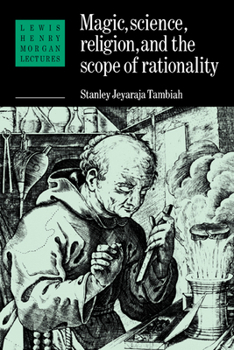Magic, Science and Religion and the Scope of Rationality
Select Format
Select Condition 
Book Overview
Professor Tambiah is one of the leading anthropologists of the day, particularly known for his penetrating and scholarly studies of Buddhism. In this accessible and illuminating book he deals with the classical opposition of magic with science and religion. He reviews the great debates in classical Judaism, early Greek science, Renaissance philosophy, the Protestant Reformation, and the scientific revolution, and then reconsiders the three major interpretive approaches to magic in anthropology: the intellectualist and evolutionary theories of Tylor and Frazer, Malinowski's functionalism, and L vy-Bruhl's philosophical anthropology, which posited a distinction between mystical and logical mentalities. He follows with a wide-ranging and suggestive discussion of rationality and relativism and concludes with a discussion of new thinking in the history and philosophy of science, suggesting fresh perspectives on the classical opposition between science and magic.
Format:Paperback
Language:English
ISBN:0521376319
ISBN13:9780521376310
Release Date:March 1990
Publisher:Cambridge University Press
Length:200 Pages
Weight:0.67 lbs.
Dimensions:0.5" x 6.0" x 9.1"
Customer Reviews
1 rating
Tambiah's internal framework of science schemata
Published by Thriftbooks.com User , 21 years ago
Concerning Tambiah's inquiry into science in this book:In "Magic, Science, Religion, and the Scope of Rationality," Harvard anthropologist Stanley Tambiah examines the logic and sociology of scientific inquiry. Tambiah identifies (see figure on page 141) the internal framework of scientific inquiry as a collection of relations between, on the one hand, bodies of specialized knowledge (rectangles) and, -- on the other, subdisciplines, specializations with conventions and "rules of the game" (ovals) accepted by peer groups and professional associations. Tambiah suggests"that the Western conception of science as a labeled, self-conscious and reflexive activity of experimentation, measurement and verification matured in the sixteenth and seventeenth centuries in Europe, that at this time there was a decisive separating off of Christianity (Protestantism) from science, and the repudiation of a third realm of activity as magic. . . . A very critical precondition of modern science was the contribution of early Greece. According to the classicists it was in early Greece that the systematization of the rules of demonstration and proof was begun, and the marking off of nature as the domain of regular laws of causality was achieved (p. 140)."While Tambiah's historical explanation situates science in relation to magic and religion, the chart on page 141 is schematically useful to orient the internal framework of science in relation to external frameworks (of special contemporary interest), namely to 1) technological applications and interventions in society, 2) the social construction of knowledge / cosmological and ideological belief systems, 3) soico-political and economic interests in society, and 4) the impact of "external history." To gain useful purchase on the sociology of science, see this chart / figure.





